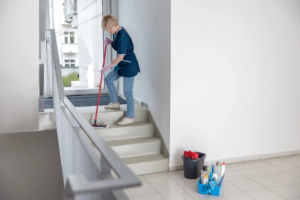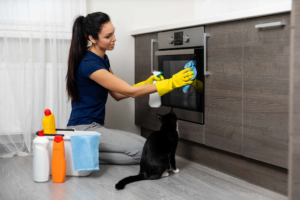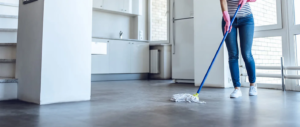Non-Toxic House Cleaning That’s Pet- and Kid-Friendly
Many people are rethinking the products they use to clean their homes. The bottles under the sink often contain harsh chemicals that can irritate the skin, trigger allergies, or leave behind strong fumes. For families with children or pets, the risks feel even greater. That’s why more households are asking: Non-Toxic House Cleaning?
Non-toxic cleaning focuses on using safe, natural products that are tough on dirt but gentle on people and animals. Instead of synthetic chemicals, it relies on ingredients like vinegar, baking soda, castile soap, and plant-based cleaners. These options clean just as effectively without filling your home with unnecessary toxins.
In this guide, we’ll explore why non-toxic cleaning matters, the common chemicals to avoid, and which natural solutions actually work. We’ll also share tips for choosing safe products, avoiding greenwashing, and even highlight the least toxic cleaners available. By the end, you’ll know how to keep your home fresh, safe, and healthier for everyone.
Why Non-Toxic Cleaning Matters?
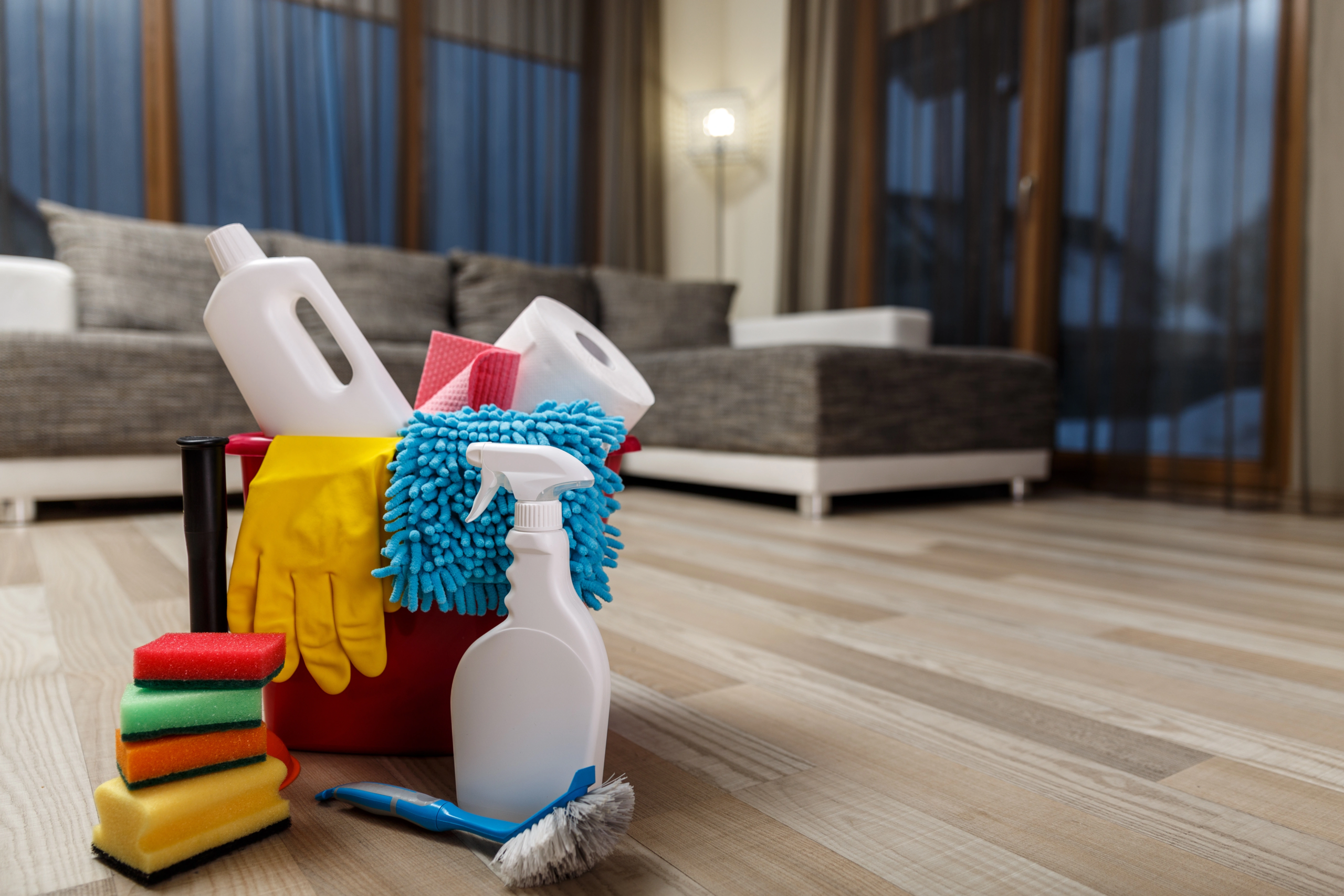
Traditional cleaning products often promise powerful results, but many contain chemicals that can be harmful over time. Ingredients like ammonia or chlorine bleach may clean surfaces quickly, yet they release strong fumes that can irritate the lungs and eyes. For children, pets, or anyone with asthma or allergies, this exposure can be especially risky.
Non-toxic cleaning matters because it protects both your health and your living environment. A healthier home starts with better indoor air quality. By avoiding harsh chemicals, you reduce the chances of breathing in irritants every time you wipe down a counter or scrub a floor.
There’s also the peace of mind factor. Parents and pet owners feel more comfortable knowing their kids can crawl on freshly cleaned floors or pets can lounge on the sofa without being exposed to residues from toxic cleaners.
Beyond health, non-toxic cleaning supports sustainability. Many safe alternatives use biodegradable ingredients and eco-friendly packaging, reducing the impact on waterways and the planet. In short, choosing non-toxic cleaning is a win for your health, your family, and the environment.
Common Toxins Found in Household Cleaners
Many everyday cleaning products contain chemicals that can harm your health and the environment. Knowing what to avoid is the first step toward safer cleaning. Here are some of the most common toxins found in household cleaners:
- Ammonia – Often used in glass and stainless-steel cleaners, ammonia can irritate the lungs and eyes.
- Chlorine bleach – A strong disinfectant found in bathroom and laundry products. It releases fumes that can cause breathing problems and skin irritation.
- Phthalates – Chemicals used to create fragrance in sprays and cleaners. They are linked to hormone disruption and are often hidden under the vague label “fragrance.”
- Formaldehyde – Sometimes found in all-purpose cleaners and air fresheners. It is a known irritant and a suspected carcinogen.
- Quaternary ammonium compounds (“quats”) – Found in disinfectant sprays and wipes. They can trigger asthma and are linked to skin irritation.
The issue is not just exposure; while cleaning residues can linger on surfaces and in the air long after you’ve finished. That’s why switching to non-toxic alternatives is important for maintaining a safe and healthy home.
Effective Natural and DIY Cleaning Solutions
You don’t need a cupboard full of harsh chemicals to keep your home spotless. Many safe, natural ingredients found in your pantry or local store can clean just as effectively and at a fraction of the cost. These options are especially good for families with kids or pets, since they don’t leave behind toxic residues.
Here are some of the most effective non-toxic staples:
- Vinegar – A natural disinfectant that breaks down grease, kills odors, and leaves windows streak-free. Mix equal parts vinegar and water in a spray bottle for a powerful all-purpose cleaner. Add a few drops of essential oil, like lavender or lemon, to cut the vinegar smell.
- Baking soda – Mildly abrasive, it’s perfect for scrubbing sinks, stovetops, and bathtubs without scratching surfaces. Sprinkle it on carpets before vacuuming to absorb odors.
- Lemon juice – Naturally acidic, lemon juice dissolves soap scum, removes stains, and leaves a refreshing citrus scent. A halved lemon dipped in baking soda makes a great sink scrub.
- Castile soap – A plant-based soap that is gentle yet effective. Mix with water to wash dishes, mop floors, or clean counters. It’s biodegradable and safe for septic systems.
- Hydrogen peroxide – A safe disinfectant that kills bacteria and viruses without harsh fumes. Use it in place of bleach for sanitizing cutting boards or bathroom tiles.
DIY Cleaning Recipes
- All-Purpose Spray – 1 cup water, 1 cup vinegar, 10 drops essential oil. Use on counters, glass, and most hard surfaces.
- Non-Toxic Scrub Paste – ½ cup baking soda, a few tablespoons of castile soap, and a splash of water. Great for ovens, tubs, and sinks.
- Fresh Carpet Deodorizer – Mix 1 cup of baking soda with 10 drops of essential oil. Sprinkle, wait 15 minutes, then vacuum.
These DIY solutions are safe, affordable, and highly customizable. With just a few ingredients, you can tackle nearly every cleaning task in your home while keeping your space healthier and safer for kids, pets, and guests.
Safe Non-Toxic Products and Trusted Brands
While DIY cleaners are effective, many people prefer the convenience of store-bought products. The good news is that there are several trusted non-toxic brands that offer safe, eco-friendly cleaning solutions without harmful chemicals.
Some of the most popular and widely available options include:
- Seventh Generation – Known for plant-based formulas and transparent ingredient lists.
- Attitude (Canada) – A Canadian brand offering non-toxic, hypoallergenic products. ECOLOGO Certified and safe for families and pets.
- Method – Offers stylish, biodegradable cleaners with recyclable packaging.
- Mrs. Meyer’s Clean Day – Plant-based formulas with essential oils for a pleasant scent.
- Eco-Max (Canada) – Affordable, plant-based products certified by Environmental Choice.
Certifications to Look For
- EWG Verified
- EPA Safer Choice
- Made Safe
- EcoLogo (Canada)
A Note on Greenwashing
Not all products labeled “natural” or “eco” are truly safe. Some brands use vague terms to appear eco-friendly without disclosing full ingredients. Always check labels and certifications to avoid being misled.
Trusted non-toxic brands provide both safety and convenience, making it easier to maintain a clean and healthy home without mixing your own solutions every time.
How to Choose Non-Toxic Cleaners
With so many products on the market, it can be tricky to tell which cleaners are truly safe and which just have “green” packaging. Here are some practical tips to help you make the right choice:
- Read the ingredient list – Look for clear, simple ingredients like vinegar, plant-based surfactants, or essential oils. Avoid vague terms such as “fragrance” or “proprietary blend.”
- Check for third-party certifications – Seals like EWG Verified, EPA Safer Choice, Made Safe, or EcoLogo are strong indicators of product safety.
- Watch out for harsh chemicals – Avoid cleaners with chlorine bleach, ammonia, or synthetic fragrances, especially if you have children or pets.
- Research the company – Transparent brands that share their ingredient sourcing and safety data are usually more trustworthy.
- Test before committing – Try a small bottle first to ensure it meets your needs.
Choosing non-toxic cleaners is about knowing what’s inside the bottle. With a little attention, you can find products that are safe, effective, and align with your values.
What Is The Least Toxic Cleaner?
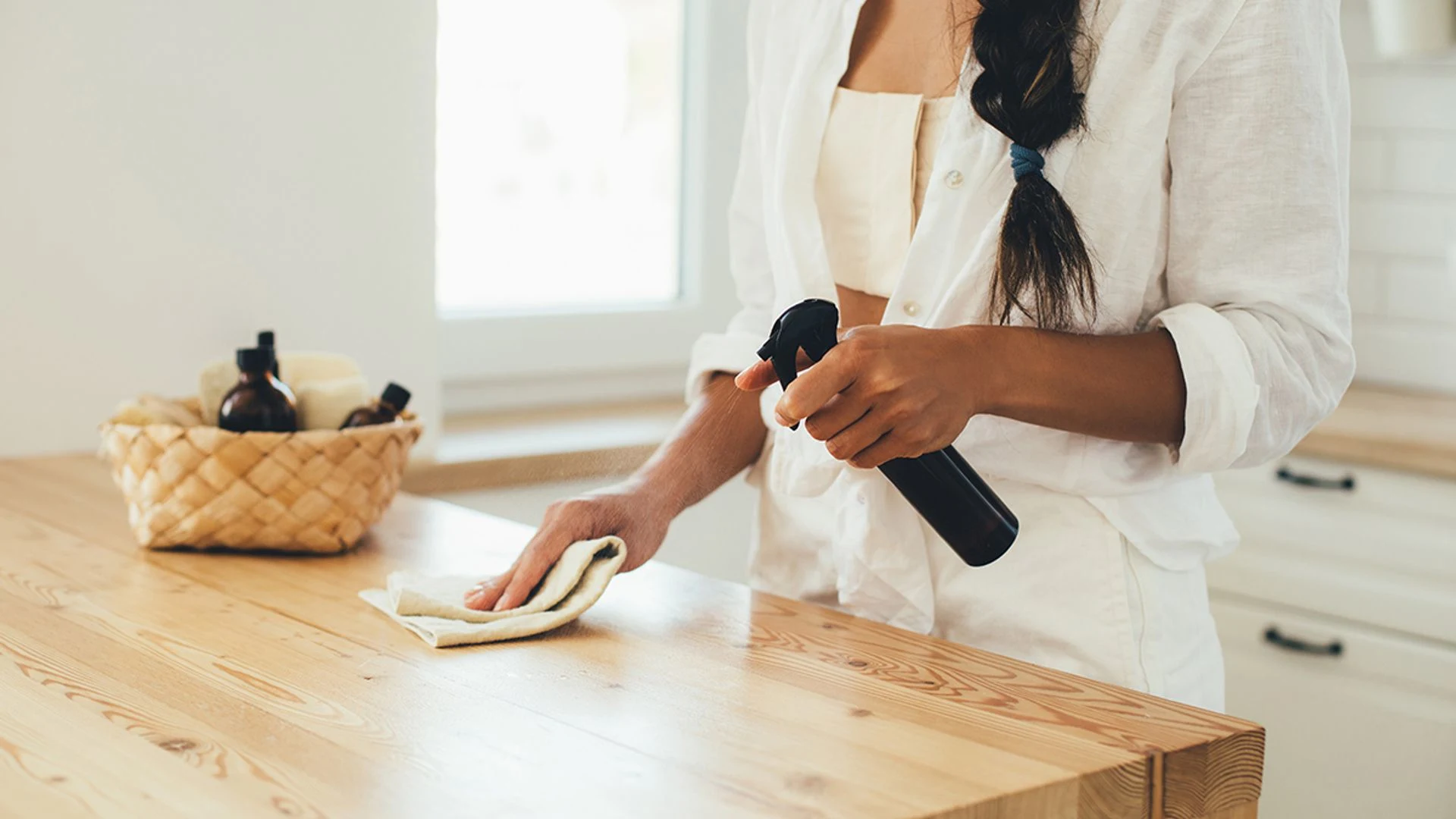
When it comes to safety, simplicity is best. The least toxic cleaners are often the ones made from single, natural ingredients you may already have at home. These options are effective, affordable, and safe for kids and pets.
- Vinegar – One of the safest and most versatile cleaners. It naturally disinfects, cuts grease, and deodorizes.
- Baking soda – Gentle but powerful. It scrubs away grime without scratching surfaces and absorbs odors.
- Castile soap – A biodegradable, plant-based soap that cleans dishes, floors, and counters without harmful residues.
- Lemon juice – Naturally acidic, lemon juice removes stains, dissolves soap scum, and leaves a fresh scent.
- Plain water – Warm water with a microfiber cloth can remove dust and dirt without any added product.
These everyday items are as non-toxic as it gets. They’re safe for families, pets, and the environment, making them the perfect starting point for a healthier cleaning routine.
Tips for Transitioning to Non-Toxic Cleaning
Switching from traditional cleaners to non-toxic options doesn’t have to be overwhelming. By making small changes over time, you can create a safer and healthier home without wasting money or effort.
- Start with high-use areas – Focus first on kitchens and bathrooms where chemical exposure is highest.
- Swap one product at a time – Finish what you have, then replace it with a safer option when restocking.
- Try DIY solutions – Begin with simple recipes like vinegar and water spray or baking soda paste.
- Reuse bottles and tools – Refill spray bottles and use washable microfiber cloths instead of disposables.
- Buy in bulk – Stock up on safe staples like vinegar, baking soda, and castile soap to save money.
By making gradual swaps, you’ll reduce toxins in your home and create a cleaning routine that’s sustainable and easy to maintain.
Mistakes to Avoid (Greenwashing & Mixing Chemicals)
As more people switch to eco-friendly products, the market has exploded with “green” and “natural” options. Unfortunately, not all of them are as safe as they claim.
- Falling for greenwashing – Don’t rely on buzzwords like “eco-friendly” or “green” without checking the ingredient list or certifications.
- Ignoring hidden toxins in fragrance – “Fragrance” may hide harmful chemicals like phthalates. Choose fragrance-free or essential-oil scented options.
- Mixing the wrong DIY ingredients – Never mix vinegar with bleach (toxic chlorine gas) or vinegar with hydrogen peroxide (can form peracetic acid).
- Assuming all “natural” ingredients are safe – Some essential oils can be irritating for kids or pets. Always research before use.
Avoiding these pitfalls ensures that your cleaning routine is truly safe and non-toxic.
Final Thoughts
Switching to non-toxic house cleaning is one of the simplest ways to create a safer and healthier home. By replacing harsh chemicals with natural solutions like vinegar, baking soda, and castile soap, you protect your family, pets, and the environment. Choosing trusted brands, learning how to read labels, and avoiding greenwashing ensure that the products you bring into your home truly live up to their promises.
The best part? Non-toxic cleaning doesn’t mean sacrificing results. With the right products and a few DIY recipes, you can keep every corner of your home fresh, clean, and safe.
If you want a deeper clean without the hassle, consider calling in the professionals. ProClean’s House Cleaning Langley specializes in safe, non-toxic cleaning services that are kid- and pet-friendly. Their experienced team takes the stress out of housework while ensuring your space is spotless and free from harmful chemicals. Contact us today!
Follow us on our socials here:
Find out more articles that can help you below:
How to Keep House Clean With a Dog

